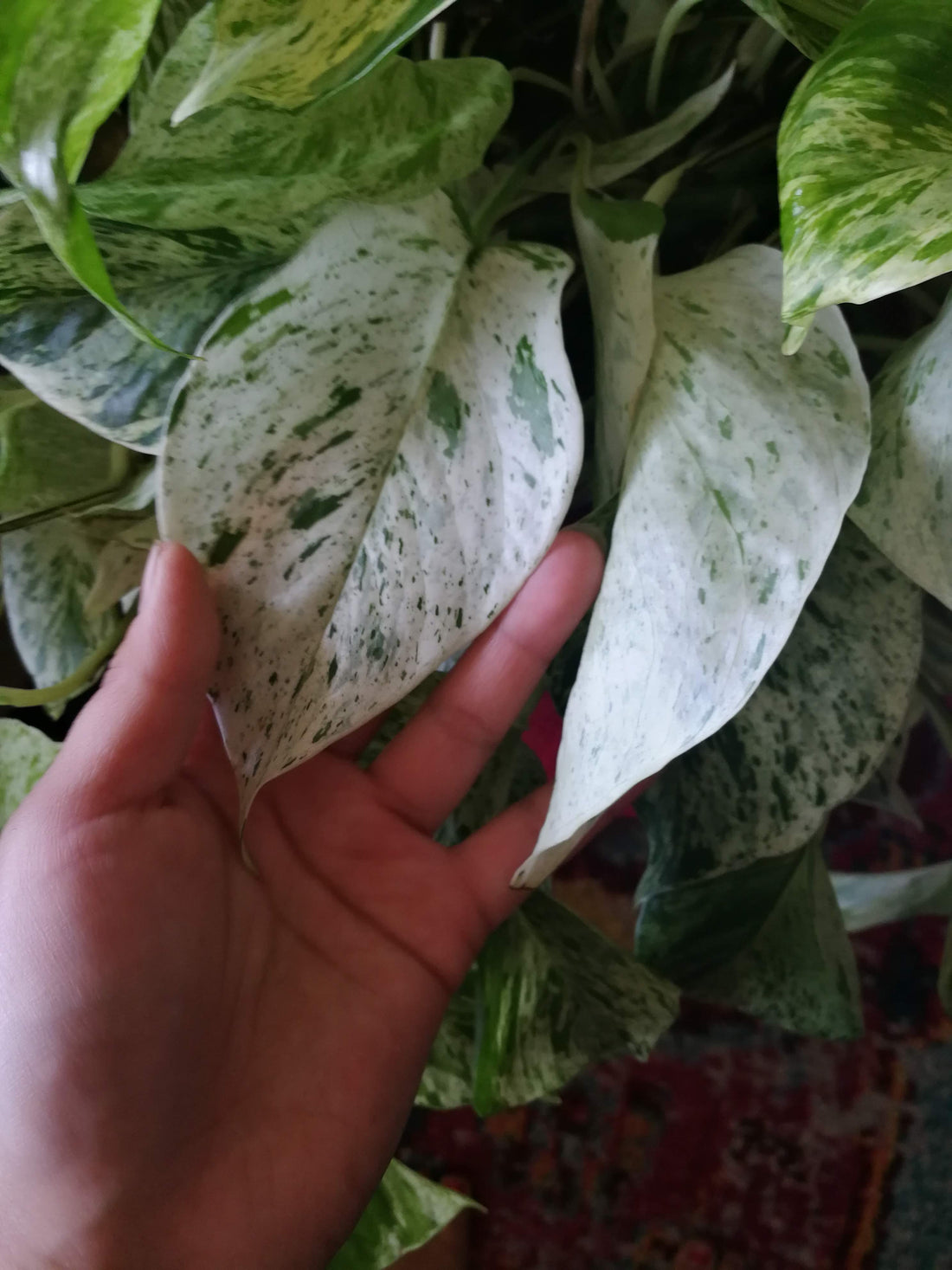
Variegation 101
Share
Welcome, plant friends!
Firstly, What is "variegation" exactly?
Variegation refers to the presence of varying colours on the leaves or stems of plants[1]. When talking about variegation in houseplants, it's essential to understand its causes and the numerous ways that it can express itself in our botanical babies.
Let's talk about the three common types of variegation (and its causes)
1. Chimeral Variegation



From left to right (philodenron brasil, golden pothos (devil's ivy), hoya krimson queen, and marble queen pothos
The most common type of houseplant variegation, a houseplant that exhibits green, white, or yellow on its leaves or shoots, is known as a "chimera." I'm a sucker for these guys. Some well-recognized chimeras include marble queen pothos, devil's ivy, and of course, the monstera albo borsigiana aka the variegated monstera. Note that the non-green portions on the leaves lack our plant friends’ life-giving powerhouse, chlorophyll. Without it, plants are unable to absorb sunshine and, therefore, unable to convert it into energy to live their best lives! Those green parts, in turn, work double-time to make up for the missing hues that cause that striking contrast. Hard facts[2].
2. Natural Variegation

prince of orange
Remember that some plants simply have those stunning variegations etched into their DNA. Unlike the chimera, these plants pass down the variegated gene from plant generation to plant generation, so the succeeding plant displays the same variegation in its foliage! Isn’t that amazing? My favourite examples of plants exhibiting this specific form of variegation include the stripe-y wonder calathea beauty star and the calathea makoyana[3]. Some other plants that carry this mutation are the pink princess philodendron and the philodendron prince of orange. These plants show off a brighter hue than white or cream. More specifically, a bubble-gum pink and a fiery orange! Note that some growers selectively breed these variegated beauties. Those newer creations are called ‘cultivars.’
3.Blister Variegation

This last kind of variegation is also commonly seen in our classic houseplants (for example, the Scindapsus Pictus, aka Satin pothos). Blister variegation occurs when air pockets form between the lower and upper layers of the leaf. Light reflects off of these transparent air pockets and gives the leaves a silvery sheen. Have you ever seen a satin pothos’ glittery sheen in the light? Such a wonder! Blister variegation can also be found in the veins of plants and not necessarily spotted like the Satin pothos. The lighter-coloured veins of anthuriums and philodendrons show this distinct variegation along its leaves. Other examples can include the alocasia frydek, philodendron gloriosum, or anthurium clarinervium [4].
Viral Variegation (Yikes!)
What’s valuable about knowing a plant’s specific type of variegation, you ask? To AVOID THE DREADED MOSAIC VIRUS, that’s why! It’s a wild ride. This virus produces a speckled colour-contrast that can look a whole lot like other forms of variegation in plants. There’s no cure once a plant is infected, so don’t even bother trying to rescue that mosaic virus-infected plant off of the clearance shelf because you can’t. Fungicides won’t help it, and neither will replanting an infected crop’s seeds.[5] We could go on and on about the importance of steering clear of the mosaic virus. If you want to read more about it, let me know in the comments!
Cultivars, Varieties, Hybrids, Tissue Culture?
Earlier in the article, I briefly mentioned the term "cultivars". Here at a jungle in the city, we can go quite in-depth regarding this topic, but to remain on track on the subject of variegation, we’ll go more in detail regarding cultivars and such in a separate article so stay tuned! But for a quick explanation to satiate curiosity, a cultivar is a variety of plant that is produced through selective breeding to retain desirable characteristics.[6]

at Montreal's Biosphere Environmental Museum
Did you know that some plants are cultivated through tissue culture? This means that they were grown and developed in a strictly-controlled laboratory setting such as the show-stopping Thai constellation monstera. These enchanting specimens are grown through tissue culture in Thailand. The controlled environment in which they are created plus the import fees make these botanical babes the so-called “unicorns,” and for a good reason too. The rarity of these plants on the market is what keeps them desirable (and insanely expensive) for hardcore plant collectors. Thai Constellations are deliberately cultured to create their speckled variegation to resemble the starry night sky, hence its name, constellation.
Can I propagate variegated plants?
It depends on what kind of variegated plants we’re talking about here. Remember, variegation can both be inherited or happen randomly. Inherited variegation is ingrained in the plant’s DNA, whereas the latter is chimeric—and may be unstable[7]. If your botanical babe’s variegation is genetic, meaning that it was just born that beautiful way, then go ahead and take a shot at propagating. The varying colours are stable and will reflect on the new plant baby. Yay!
